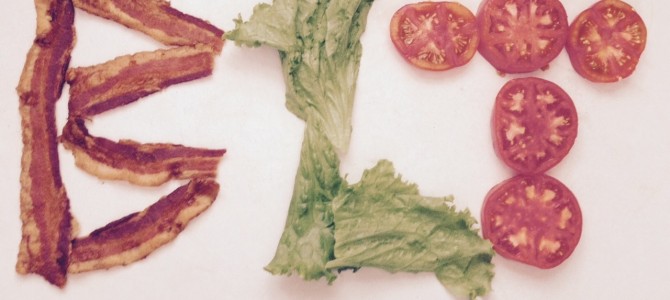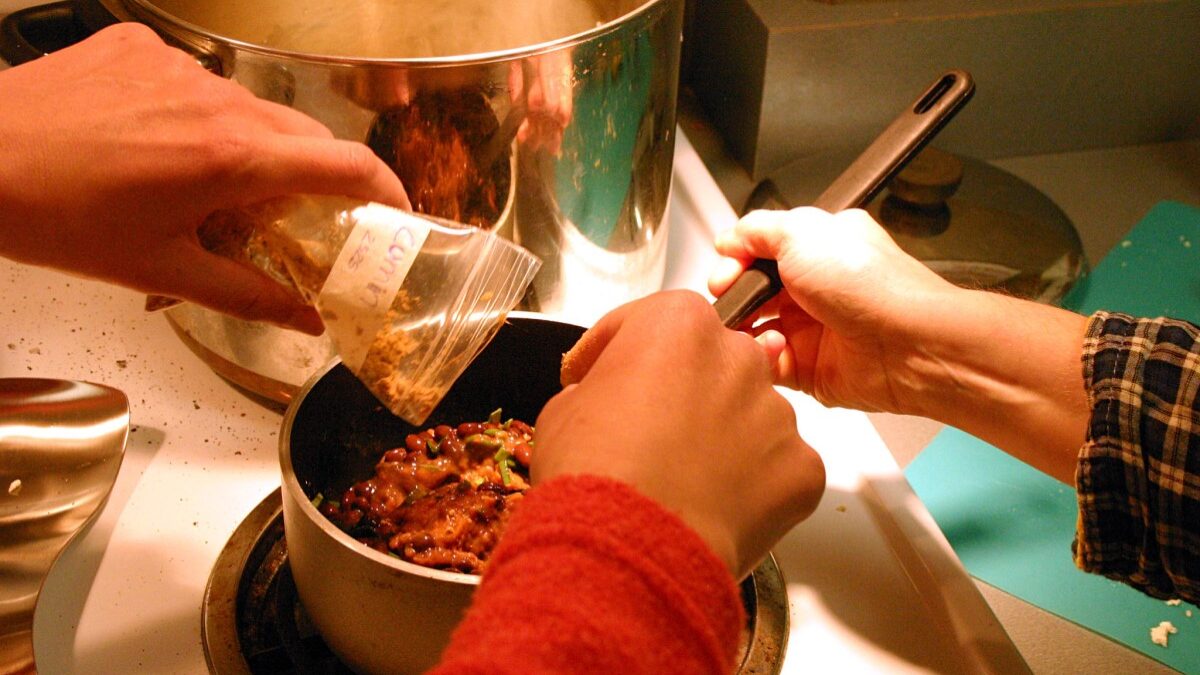
America, as a general rule, does not glory in its own cuisine. We have celebrity chefs these days, of course, and we have become very culinarily advanced since the bad old days when cheese was orange (as Alice Medrich once put it) and lettuce had some mysterious connection to icebergs. But we have borrowed heavily from other cuisines—from the Italians quite a lot these days, which is hardly a bad thing, or from France or Spain or the Pacific Rim. We tend to underestimate the products of our own native culinary genius. Which is a shame.
What better place to start correcting this than with a dish that is not only quintessentially American, but also reaches its apotheosis now, in the middle of summer: the BLT.
The bacon, lettuce, and tomato sandwich evolved from Victorian “tea sandwiches” as a variation of the club sandwich. But it reached its heyday in the mid-20th century; the first references to BLT as an acronym date to 1950.
One website informs us that April is “National BLT Month,” but this makes absolutely no sense, because we all know that the BLT is the official sandwich of summer. The reason is simple: you can eat bacon any time of the year, but you can only have a proper BLT when you have access to really good, fresh tomatoes. For most of the country, that means July or August. According to Wikipedia, “BLT sandwiches are popular especially in the summer, following the tomato harvest. In the USA, the BLT season is associated with an increase in the price of pork-bellies, which are processed into bacon.” I have no idea if this is actually true, but it ought to be true.
What follows are my recommendations for how to make the “perfect” BLT. I am, however, a firm believer in the principle of de gustibus non disputandum, so your preferences may vary, and far be it from me to tell you how you have to make a BLT. But the recommendations below come from years of careful thought and experimentation, and they lay down general principles that will help you in making your own decisions.
Since the availability of fresh tomatoes is what kicks off the BLT season—from July through September, I practically live off of them—let’s start with the tomatoes.
Tomato
A good BLT is really an exercise in creating harmony between very different flavors. The fundamental contrast in a BLT is between the smoky, meaty, fatty taste of the bacon, and the bright, juicy, fresh vegetable taste of the tomato. The tomato is not a mere garnish, but an integral part of the experience. This is not a “bacon sandwich.” It’s a BLT, and the “T” gets equal billing.
So you need a very flavorful, fresh tomato. The best option, of course, is to grow your own. A half-dozen big tomato plants in a raised bed is great, and that’s my current set-up, but I’ve been able to grow them in large pots on the front porch. It can take a little work to protect them from insects and deer and birds, to keep them watered enough but not too much, but it’s worth it.
You should seek out old-fashioned “heirloom” varieties, which is a way of saying they were bred for how they taste rather than for their ability to look good on the supermarket shelves. I prefer to grow big, oval beefsteak tomatoes, which have deep, complex flavors and a center packed with the flavorful “meat” of the tomato with fewer of the open chambers filled with seeds. They are also the ideal size. As we shall see, a single slice cut from the middle of a good-sized beefsteak tomato will cover the entire area of a sandwich.
In short, the best way to find a tomato for a BLT is like this:

What to do if you do not have your own tomatoes in your own garden? Befriend someone who does. Chances are that you have a friend, neighbor, or coworker who grows tomatoes. During the height of the harvest, we often have more tomatoes coming ripe than we can use ourselves, and what is more important, we have an inbuilt, primordial urge to flaunt our tomatoes. So ask us about our tomatoes and show some interest. When we bring tomatoes into the office, even if only for our own use, remark about how good they look and how delicious they must be. Eventually, we just might bring you a little basket full of fresh tomatoes.
If you aren’t lucky enough to have friends or neighbors like this, you can lurk around farmer’s markets, of course, and in this culinarily enlightened age some of the fancier supermarkets will carry a small selection of heirloom varieties, often marketed somewhat apologetically as “ugly tomatoes”—as if looking like an actual, real tomato were somehow unappealing. They will look like this, which I happen to find very pretty.

It is possible that you can only find the regular kind of supermarket tomato: uniformly round, uniformly red, and uniformly bland. Like this:

If this is the case, don’t despair. There is still one thing you can do to salvage the situation: just eat the bacon.
A good tomato speaks for itself, of course, but there is one thing you absolutely must do to help it: sprinkle on a little salt. There’s an old adage: salt is the spice that makes things taste bad when it’s not in them. Salt amplifies the natural flavor of whatever you add it to, and vegetables with a lot of water in them tend to need a fair bit of salt. There’s plenty of salt in the bacon, but you’re going to need some applied directly to the surface of the tomato. If you are the sort of person to invest in a fancy sea salt, this is the time to use it. Sea salt’s wide, crystalline flakes are more pleasant on the tongue than the dense cubes of granulated table salt, which can deliver a harsh flavor. I also add just a little bit of black pepper, which also seems to amplify the flavor of the tomato.
But we’re getting a bit ahead of ourselves. This is, after all, a sandwich, and when we’re making it, we start with the bread.
Bread
The basic principle when selecting bread for a sandwich is that the firmness of the bread should match the firmness of whatever is going in the sandwich. A firm bread placed around a soft filling will just cause the inside of the sandwich to come oozing out the sides, while a soft bread with a chewy filling will slide off of the ingredients inside and turn into mush before you’ve finished chewing apart your cold cuts. So you would choose a soft white bread for an egg-salad sandwich, for example, or a firm rustic loaf for a panini loaded with prosciutto.
The BLT requires more of a medium-density bread—soft enough not to crush the tomato, but firm enough not to be crushed against the bacon. I usually use this, a “country” white bread:

Note also that this is a wider loaf, more of a rectangle than a square, so it makes a larger, heartier BLT. In fact, the width of the slices is exactly one-half the length of a cooked slice of bacon, which can’t be coincidence.
Yes, you can go fancier, and I suppose you could make this sandwich with pain de mie. But this is an American sandwich, and that just seems to frou-frou and French for everyday eating. You can also get all “healthy” and try something with whole wheat. But then you risk having the flavor of the bread compete too much with the main ingredients. And after all, you’re eating a sandwich with bacon, so who are you fooling about this “healthy” stuff?
You should toast the bread lightly, partly because it adds a nice browned flavor, partly because it makes the bread a little firmer, and mostly because that’s just tradition. So it will look like this:

This provides the foundation on which to put the next ingredient, which brings us to the lettuce.
Lettuce
Actually, before the lettuce comes the mayo. It doesn’t make top billing, but it is essential. The mayo performs an important practical function: it is a barrier that prevents the juices of the tomato from soaking into the bread and making it mushy. But it also adds a key component of the taste.
Think of it this way. If you took away the bread, what would a BLT be? You would just have tomato and lettuce and bacon, and that would be…a salad. And if you have a salad, you need a dressing, right? That’s basically what a BLT is: it’s a bacon salad made into a sandwich, and the mayo is the dressing. That’s why I like the tangy zip of Miracle Whip, a whipped mayonnaise souped up with small amounts of additional spices like paprika. After all, Miracle Whip advertises itself as a salad dressing, not just a sandwich spread. It is also another distinctive American creation, having premiered in 1933 at the World’s Fair in Chicago.
If the BLT is really a salad on a sandwich, that helps us pick the lettuce. We want something with good flavor, so not the stuff with that mysterious connection to icebergs. It has to have a crispy texture to balance against the other two main ingredients—the chewiness of the bacon and the softness of the tomato. So no fancy micro-greens. A romaine would be good, but I find the ribs too crunchy and not flavorful enough. So I choose a regular green-leaf lettuce, curly and moderately crisp with a bright, fresh flavor.
I put it on right after the mayo, because if the mayo is the salad dressing for the lettuce, then the two should be together. Like this:

That leave us with the bacon.
Bacon
This is the biggest, most intense punch of flavor in the sandwich. It’s the flashy star whose job is to “carry” the picture.
It should be smoked, of course, but otherwise should not have any kind of added flavor, such as Maple syrup. I go for the thickest bacon I can find, partly because that means more of the smoky outer edge per piece, and also because it gives a substantial, meaty texture. I use a commonly available brand called Wright. It can be found at a very reasonable price at my local Walmart, has a great, smoky flavor, and is probably the thickest thick-cut bacon out there, with slices about one-fifth of an inch thick.
So then you have to cook the bacon, and everybody knows how to cook bacon, right?
No, you don’t.
You normally would cook bacon by throwing it in a skillet and frying it. But there is a better way, which is commonly used in the restaurant industry. I learned it from my father in law but added a few improvements. The best way to cook bacon is in the oven.
Take an aluminum half sheet pan, like this:

Line it with extra-wide heavy duty aluminum foil, which will catch the rendered fat and make cleanup easier. Then place a wire rack on top of the sheet pan and lay the bacon across the rack, like this:

Place it in a 375° oven and bake for about 30 minutes.
There are a couple of big advantages to this method. The main one is that the bacon gets heated exactly evenly from the top and the bottom, so it doesn’t curl up and comes out completely flat. Like this:

You also avoid the other big problem that happens when bacon curls: the parts that still touch the bottom of the pan get heated too much and tend to get burned, while the parts that curl off of the pan are undercooked and don’t render enough of their fat. The perfectly flat bacon, by contrast, is also perfectly evenly cooked.
Perhaps the best part about this method is that it requires very little labor (which is why it’s used by restaurants). You don’t have to stand over a pan getting spattered by hot grease as you turn the bacon over trying to cook it evenly. You just stick it in the oven and do something else for a half an hour. This is really helpful if you want to make a very large amount of bacon, and in the middle of BLT season, that’s exactly what you should be doing. I get my bacon in three-pound packs and often cook two packs at a time. That may sound like a lot, but now that my boys are a little older, it disappears surprisingly fast.
This method also cooks the bacon more slowly, so it’s very easy to bring it to exactly the desired degree of doneness. I like it a little more well-done, rendering off a lot of the fat. (Which need not go to waste: when it’s time for clean-up, take the foil at one corner of the pan and shape it into a spout to pour the bacon grease into a container for storage.) But I stop the cooking before the bacon gets fully crisp. This means it will stay in one piece rather than shattering into a dozen fragments the first time you bite into the sandwich. It also gives the bacon a chewy, meaty texture, which makes sense when you are using it as a cold cut.
I add the bacon next, breaking each piece in half and adding two or three of the halves to either side of the sandwich, depending on my supply and my mood. Like this:

If you are tempted to add more bacon, well, that’s your business. But remember that this sandwich is about the balance between the bacon and the tomato, and you don’t want to risk one overwhelming the other. That’s why I put the bacon on either side of the tomato, so that you can add one big slice of tomato, about a quarter-inch thick, across the middle of the sandwich, like this:

The tomato is totally surrounded by the bacon, and the contrasting flavors and textures are in direct contact. The final sandwich looks like this:

And the way it looks when you eat it is—well, just imagine me with a really big smile on my face.
The BLT is one of this country’s greatest achievements, one to be taken very seriously. It is not merely an excuse to gorge on bacon. (That’s what breakfast is for.) It is a sophisticated sandwich involving a complex and delicate balance of flavors: the smoky, meaty bacon; the fresh, sweet brightness of the tomato; the crisp salad flavor of the lettuce with its tangy dressing of mayo; the nutty highlight of the toasted bread. It is worth some effort to figure out what you think is the perfect balance.
Done right, it should not only be a delicious way to enjoy summer. It should also help rekindle your pride in America’s home-grown culinary traditions.
Follow Robert on Twitter.









